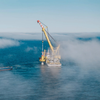Column: Security Plans Here to Stay
By Charley Havnen
Everyone in the transportation business will be dealing with security plans. Maritime, highway and railway transporters of cargo will become very familiar with the preparation and maintenance of security plans. The USCG security requirements will specify submission of security assessments and plans by January and full compliance with approved security plans by July 2004. On the other hand, the Department of Transportation (DOT) has issued interim regulations requiring security plans be in place for highway and rail transporters of placarded hazardous material (and some other commodities) by September 25, 2003, and training of transportation employees before the end of the year.
Training is a big part of the effort to control the risks associated with the potential of a security incident for DOT. Training will also be a major part of the Coast Guard security efforts, as well.
The security plans themselves will be another matter. They will be developed according to the facility or vessel risk assessment performed concerning the specific installations. These risk assessments are analyses of potential risks performed using risk-based decision-making methodology to determine the security measures needed to protect a facility or vessel. The methodology uses predetermined scenarios from which the facility or vessel must be protected.
Attacks or intrusions needing to be defended against are obvious and straightforward. Defining these threats leads one to straightforward mechanisms that may be used to defend against any specific type of attack or intrusion.
Our government is expected to defend us from certain types of attack. Some of these are relatively obvious, such as threats from aircraft, or massed assaults by armies or navies. Other defensive protection provided by the government is less obvious and more difficult to identify. Is it necessary that we arm our vessels to physically defend against hostile boardings? One would hope that such extremes will not be necessary. In most cases, the most positive defensive function is to identify potential attackers and advise the proper authorities, who will then take steps to further deter the potential attackers.
Calling the authorities works fine for a facility, particularly for potential threats that come from waterside. For a vessel underway, help may be several hours away, and the situation is much more difficult. The vessel may be providing notification to proper authorities, that their vessel is about to be taken, but beyond that, there is definitely a degree of ambiguity.
The idea of notifying authorities seems to be sanctioned by the international requirement for the ship alerting system, which is substantially a system by which a vessel operator can "phone home" about whatever threat vessel is addressing. In any event defining the known scenarios significantly eases the burden of determining how to secure a vessel or facility.
The basic scenarios include:
• Intrude, take control of target and
• Damage/destroy target with explosives
• Damage/destroy with malicious operations/acts
• Take hostages/kill people
• Externally attack
• From waterside
• From shore side
• From subsurface
• Launching or shooting weapons from a distance
• Using facility or vessel as a means of transferring
• Materials, contraband, &/or cash into or out of the country
• People into or out of the country
Additional scenarios may be added by government authorities if and when terrorist attacks occur, or may be added by companies themselves based upon what they consider to be additional risks.
The vulnerability of a facility or a vessel is a balance between the accessibility and organic security of the facility or vessel. The accessibility relates to the physical and geographic barriers that deter the threat. It includes fencing, locked doors, keyless entry systems and lighting, among other things. Organic security is the ability of security personnel to deter the attack. It includes guard force, security plans, communication capabilities, closed circuit television, and intrusion alarms and the timeliness of outside law enforcement to prevent the attack.
As part of the risk assessment, the scenarios are analyzed to determine the specific needs for modifications to mitigate potential vulnerabilities of the facility or vessel. How can these potential occurrences or scenarios be deterred, or at least be detected, and reported to appropriate authorities? While reporting to authorities is not the limit of response action, it may well be the most prudent and correct posture to entities without law enforcement powers, particularly in our litigious society. None of this increased protection comes cheaply; however, it is less expensive in the long run to utilize the accessibility through fence lines, door locks and lighting, as opposed to increasing the guard force or number of members of the crew. There is no question that any increase in the number of vessel or facility employees must be kept to an absolute minimum. Competition is king, and keeping costs low is critical to the very survival of any commercial facility or vessel operation. If the economics do not support the mandatory modification of the physical plants and the required watch keepers, the business will not survive.
Intrusion alarms and closed circuit television can also be utilized to help minimize live, on-watch personnel, but again, costs can become prohibitive.
Use of a guard force, closed circuit television, and intrusion alarms extensively are certainly a potent option, however, simple accessibility controls are generally less expensive. One must find an economic balance point that facilitates appropriate security and keeps costs palatable. Sound easy? We shall see.
One of the key elements of keeping the cost down will undoubtedly involve the designation and control of access to restricted areas on the facility or vessel. The definition varies a bit between facilities and vessels, but the objectives are the same: protect physical areas, equipment, controls, and other resources essential or critical to the continued operation of the entity, whether it is a facility or vessel.
The definition of restricted areas is rather broad and includes the following:
Vessels
• Navigating Bridge
• Enginerooms
• Control stations
• Surveillance locations
• Critical elect. feeders
• Electrical generators
• Emergency Gen. Room
• Access to pot. wtr sys.
• Haz. cargo spaces
• Haz. cargo vent. sys.
• Haz. cargo pumprooms
• Ship's stores spaces
• Crew accommodations
• Gangways
• Cargo areas
• HVAC systems
Facilities
• Shore & waterside near ships
• Embarkation areas
• Cargo landing area
• Haz. cargo storage
• Security controls
• Electrical Controls
• Cargo documentation
• Aid to navigation controls
• Lighting panels
• Essential electrics
• Comms. sys. spaces
• Access to water & other utilities
Also, other locations where access should be limited can be defined by the individual owner or operator, based on their own criteria.
Establishing and maintaining special controls for access to all of these will be very challenging, to say the least.
The problem is particularly perplexing on a vessel, where we have extremely limited ability to alter crew size and function without major vessel alterations or modifications, which may in turn make the vessel unprofitable. If the latter occurs, commerce will not survive. To complicate matters even further, restricted areas on a vessel are extremely difficult to isolate in order to control access. Locked doors cannot always be used as a means of isolating restricted areas from other areas on the vessel. An individual must be able to escape a fire or evacuate the vessel without using a key to unlock a door. Suddenly, things become more complex.
How do we maintain the ability to survive a fire and maintain a secure environment? While this is a challenge for new vessels, it is simply another set of design parameters that must be considered and incorporated into the design. For existing facilities and vessels the entire physical plant must be evaluated and analyzed to determine the best (most effective yet least expensive) methods of complying with governmental requirements. While not too difficult for a facility, it is quite complicated for an existing vessel. This is a much more complex task than for a new vessel or a facility.
Charley Havnen is a Commander USCG Ret. His organization can help you with your vessel or facility security assessment, security plans vessel construction project, regulatory problems, vessel manning issues, procedure manuals, accident analysis or serve as an expert witness. His organization can do what you can't or don't want to do, and are online at http://www.havnengroup.com. He can also be reached by contacting the Havnen Group in New Orleans: (800) 493-3883 or (504) 394-8933, fax: (504) 394-8869, or email at [email protected].









